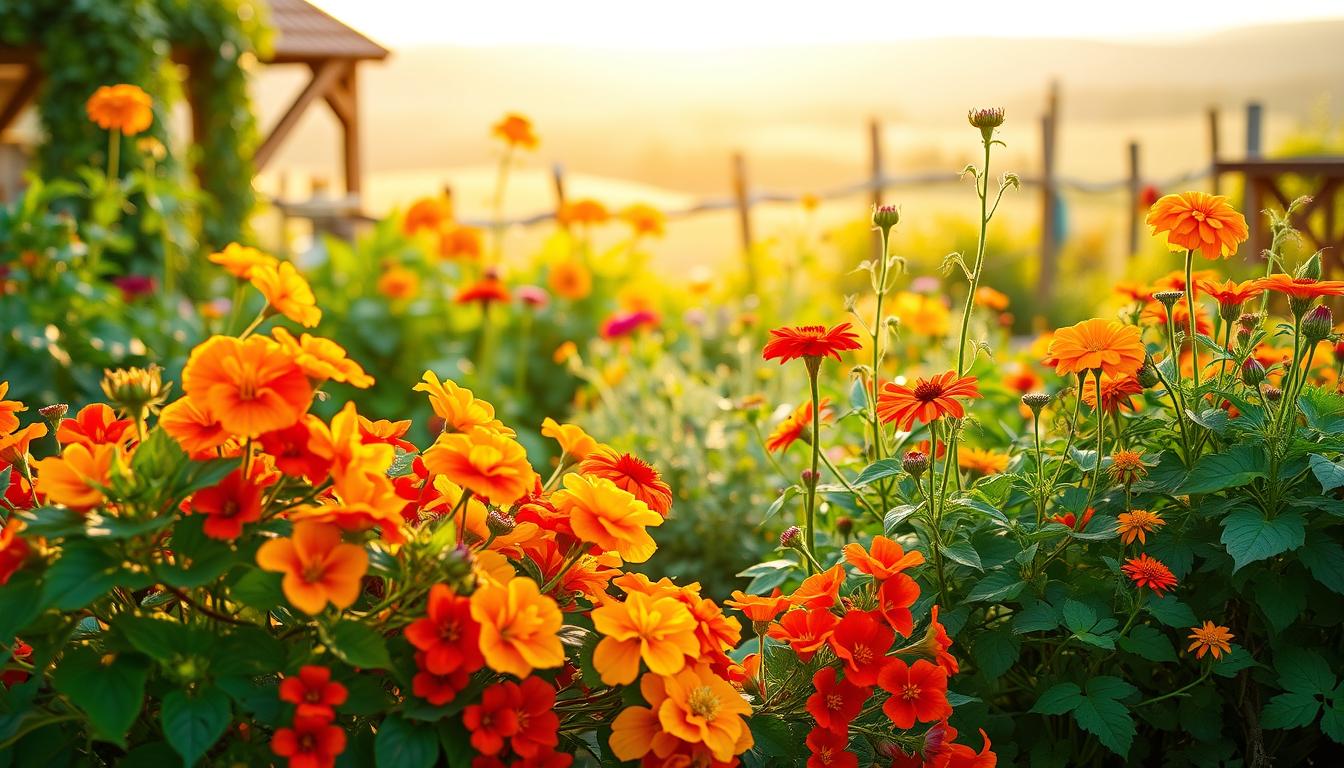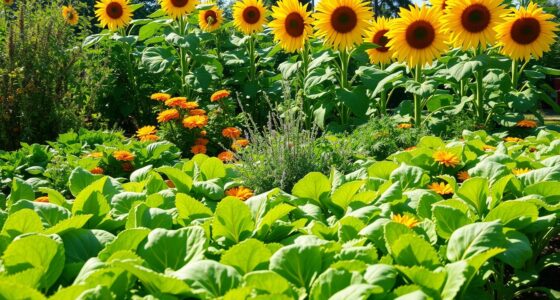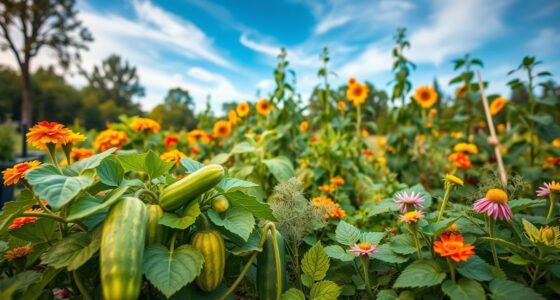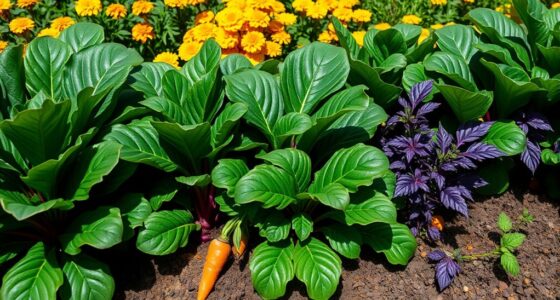Imagine stepping into your garden, a vibrant splash of colors greeting you with open petals and the sweet hum of pollinators dancing among them. In this ecosystem of life, companion planting with nasturtiums can transform not just the aesthetics but also the very health of your garden. These charming flowers, with their rich hues and delightful peppery flavor, invite a harmony between plants that benefits them all. When you explore the benefits of planting nasturtiums, you’ll discover how they attract beneficial insects, repel pests, and bring forth a flourishing garden environment. Let’s delve into the world of nasturtium companion plants and unlock the secrets to creating your own lively garden sanctuary.
Key Takeaways
- Nasturtiums enhance garden beauty and health.
- They attract beneficial pollinators.
- Nasturtiums help deter pests naturally.
- Companion planting with nasturtiums optimizes space.
- Their edible flowers add a unique flavor to dishes.
Understanding Nasturtiums and Their Benefits
Nasturtiums, scientifically known as *Tropaeolum majus*, are radiant annual flowering plants that capture the eyes of gardeners everywhere. Renowned for their bright, trumpet-shaped flowers and lush round leaves, these colorful garden plants can elevate the visual interest of any outdoor space. Whether you are exploring various types of nasturtiums or just diving into the world of gardening, these plants offer several enticing advantages.
What Are Nasturtiums?
The nasturtium plant thrives in diverse soil conditions, making it an adaptable choice for various garden settings. Known for their vibrant hues, they can range from warm oranges to deep reds and even soft yellows. The flexibility and resilience of nasturtiums make them a favorite among both novice and seasoned gardeners.
Why Grow Nasturtiums?
There are numerous benefits of growing nasturtiums that you may find compelling. Beyond their stunning appearance, these plants offer edible flowers that can enhance your salads and dishes. Packed with vitamins A, C, and K, nasturtiums provide nutritional value that elevates your meals while adding a splash of color. Additionally, they contribute to pest control by deterring unwanted garden pests, creating a healthier environment for your plants.
The Aesthetic Appeal of Nasturtiums
The beauty of nasturtiums goes beyond their nutritional benefits. Growing them adds depth and character to your garden. Their striking blooms attract pollinators such as bees and butterflies, enriching your garden’s ecosystem. Nasturtiums enhance gardening beauty and provide practical ground cover, helping to fill gaps in your garden and minimize weed growth.
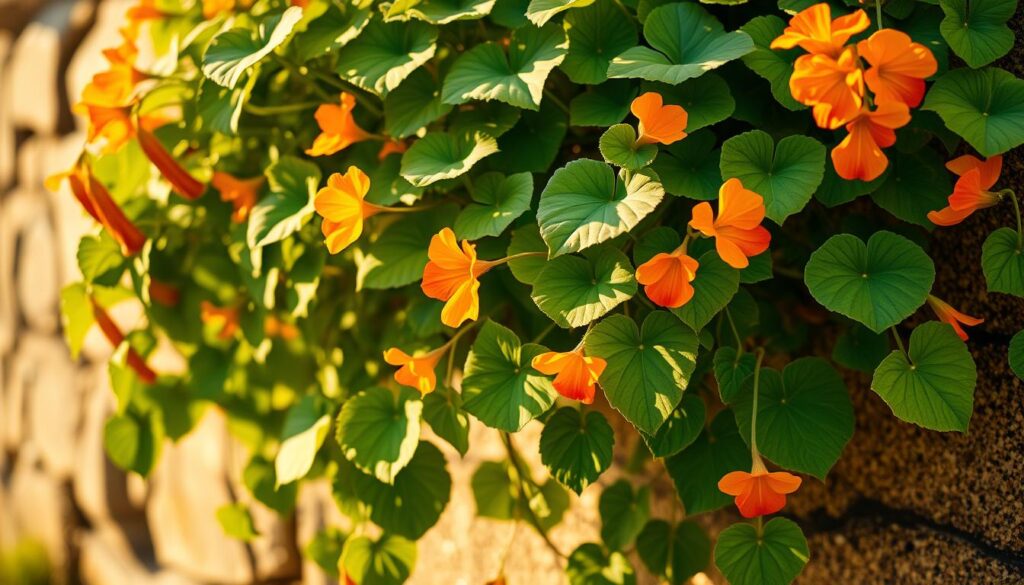
Top Companion Plants for Nasturtiums
Nasturtiums thrive when paired with the right companions in your garden. Selecting effective pairings can lead to improved growth, pest deterrents, and a flourishing environment for all your plants. Below are some top choices for companion plants that work harmoniously with nasturtiums.
Marigolds: Pests’ Worst Nightmare
Marigolds as companion plants are renowned for their ability to repel various pests, making them ideal partners for nasturtiums. When these vibrant flowers grow alongside nasturtiums, they create a formidable barrier against insects. This relationship not only enhances the aesthetic appeal of your garden but also provides essential pest deterrents, bolstering protection for neighboring vegetables.
Beans: A Mutual Benefit
Beans and nasturtiums exhibit mutual benefits in gardening, especially when it comes to attracting and repelling pests. The presence of nasturtiums draws certain pests away from beans, allowing them to thrive. Furthermore, beans contribute to nitrogen fixation, enriching the soil and benefiting nasturtiums during their growth cycle.
Cucumbers: Enhancing Flavor
Cucumbers as companion plants benefit significantly from nasturtiums, which help in controlling cucumber beetles. This natural pest control method not only safeguards cucumbers but also improves their flavor. The combination of these two plants results in a flourishing garden, where nasturtiums act as living mulch to retain soil moisture and regulate temperature, further supporting healthy cucumber growth.

Best Vegetables to Pair with Nasturtiums
Pairing vegetables effectively in your garden can yield numerous benefits, especially when combining radishes and nasturtiums. Utilizing companion planting techniques helps maintain a healthier and more vibrant garden, allowing various plants to benefit from each other’s strengths.
Radishes: Quick-Growing Allies
Radishes and nasturtiums make an excellent combination for several reasons. As quick-growing vegetables, radishes thrive in the same environment where nasturtiums flourish. Their fast maturation allows for early harvests while lying close together in the garden bed. Nasturtiums play a vital role in pest prevention by attracting unwanted insects away from radishes. This relationship ensures healthier growth for both plants, contributing to your colorful vegetable garden.
Tomatoes: Flourishing Side by Side
Nasturtiums serve as effective tomatoes as companion plants. They not only protect tomatoes from pests but also attract beneficial insects that promote flourishing tomatoes. This synergy enhances growth without competition for nutrients. When planting tomatoes alongside nasturtiums, you set the stage for a thriving partnership beneficial for both. This companion planting method ensures your tomatoes remain healthy and productive through the growing season.
Peppers: Colorful Companions
Integrating peppers and nasturtiums into your garden provides multiple advantages. Nasturtiums deter pests that commonly afflict peppers, ultimately leading to stronger plants and better yield. Their lush foliage offers additional protection by reducing the risk of soil-borne diseases. Together, peppers and nasturtiums create an aesthetically pleasing and productive space in your garden, ensuring vibrant colors and bountiful harvests all season long.
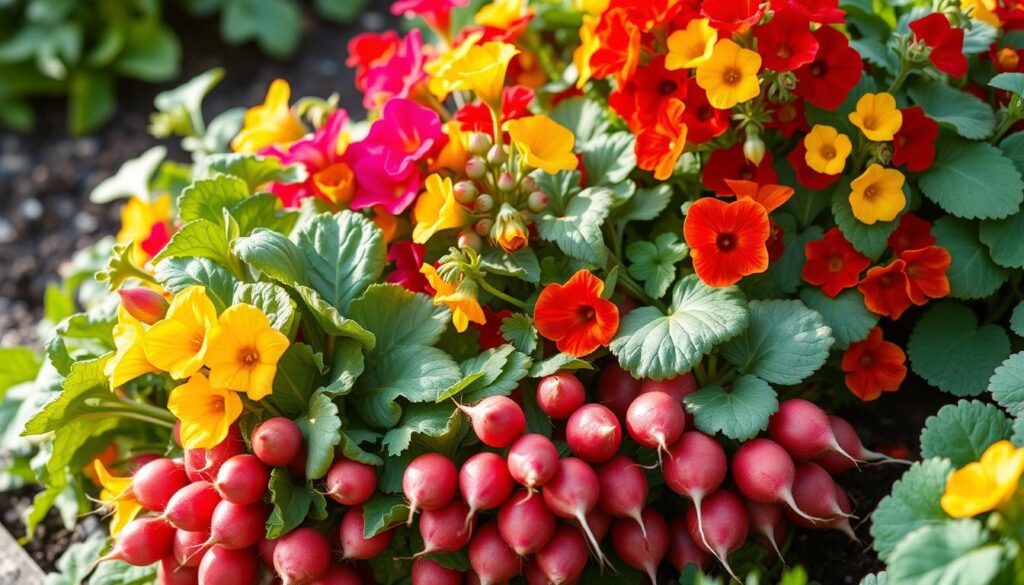
Herbs That Thrive with Nasturtiums
Nasturtiums not only add color to your garden but also play an essential role in enhancing the growth of various herb companions. By incorporating basils, oreganos, and cilantro into your herb garden, you can unlock the many companion planting benefits these hardy herbs offer. The following herbs thrive alongside nasturtiums, leading to remarkable flavor elevation and a vibrant herb garden.
Basil: Elevating Garden Flavor
Basil is a fantastic choice for herb companion planting. When planted near nasturtiums, basils in companion planting enjoy protection from pests that might otherwise damage them. This strategic pairing not only repels unwelcome insects but also supports the overall health of basil, resulting in an enhanced flavor profile and greater yields.
Oregano: A Hardy Partner
Nasturtiums provide excellent support for oregano as a companion plant. They improve growing conditions by creating a favorable microclimate, which promotes enhancing growth in oregano. With nasturtiums by their side, oregano can flourish, making them perfect additions to dishes requiring robust flavor and earthy aromas.
Cilantro: Versatile and Vibrant
Cilantro and nasturtiums create a delightful plant pairing. Cilantro benefits from the pest-repelling properties of nasturtiums, ensuring a healthy and thriving crop. This combination results in fresh, vibrant herbs that enhance multiple recipes, showcasing the beauty of robust and flavorful herb gardening.
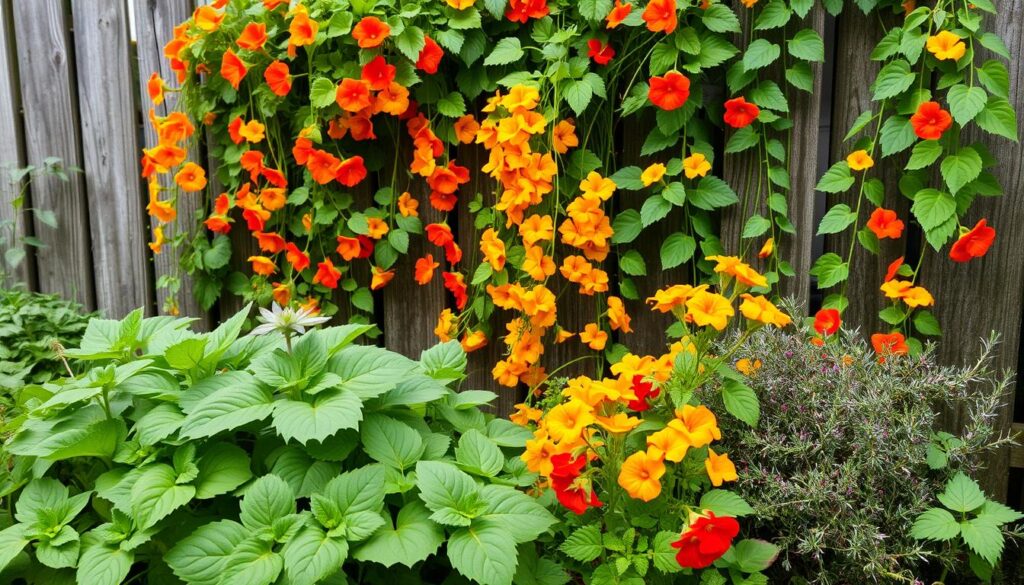
Flower Companions for Nasturtiums
Creating a vibrant garden involves selecting the right companion flowers for nasturtiums. Integrating sunflowers and nasturtiums not only enhances visual diversity but also supports a thriving ecosystem in your backyard. Consider these remarkable pairings for an extraordinary garden design.
Sunflowers: A Tall Contrast
Sunflowers serve as a striking contrast to nasturtiums, bringing a dramatic height that captivates the eye. Their vibrant blooms are not just aesthetically pleasing; they also attract beneficial pollinators and birds. This combination results in a lively atmosphere where both plants flourish. The sunflowers provide shade for the nasturtiums, nurturing their growth and contributing to overall companion planting benefits.
Zinnias: Brightening the Border
Incorporating zinnias as companion plants adds cheerful bursts of color along your garden borders. These border flowers, like nasturtiums, attract beneficial insects, making them an excellent choice for enhancing pollinator activity. The partnership between zinnias and nasturtiums contributes significantly to your garden’s visual impact, ensuring a vibrant display throughout the growing season.
Cosmos: Attracting Pollinators
Cosmos flowers complement nasturtiums beautifully, sharing the common goal of attracting pollinators. These companion flowers not only contribute to the visual appeal of your garden but also enhance its overall health and biodiversity. By planting cosmos alongside nasturtiums, you create a rich habitat that encourages a variety of beneficial insects, vital for pollination and the sustenance of your flourishing plants.
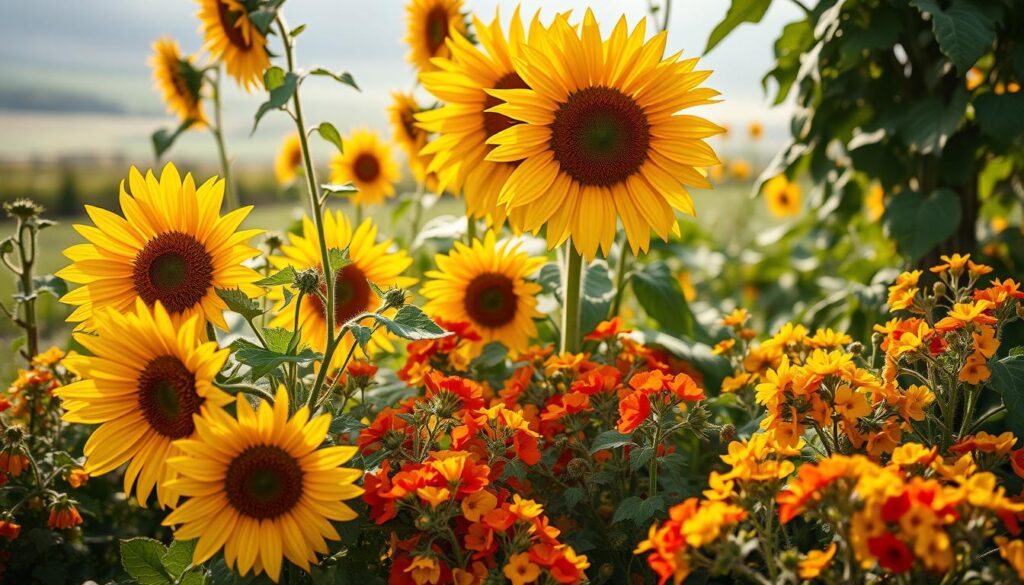
Nasturtium Uses in Your Garden
Nasturtiums are more than just beautiful flowers; they bring a variety of practical benefits to your garden. By incorporating edible nasturtiums, you can enjoy flavorful leaves and flowers, utilize their pest-repellent properties, and enhance soil health through sustainable gardening techniques. Here’s a closer look at how these edible garden plants can make a difference in your gardening experience.
Edible Leaves and Flowers
The vibrant leaves and flowers of nasturtiums are not only appealing but also packed with nutrients. You can use them in various culinary applications, from salads to garnishes. Their peppery flavor adds a special touch to dishes, making them a delightful addition to your meals. Embracing edible nasturtiums expands your options for organic gardening methods and promotes health through fresh ingredients directly from your garden.
Natural Pest Control
Nasturtiums serve as a natural pest control agent in your garden. They attract beneficial insects while deterring common pests such as aphids and whiteflies. This characteristic aligns perfectly with organic gardening methods, allowing you to maintain a healthy garden without relying on chemical pesticides. Incorporating nasturtiums helps you create a thriving ecosystem while keeping your other plants safe from harm.
Ground Cover Benefits
As a natural ground cover, nasturtiums improve moisture retention in the soil. They suppress weed growth and contribute positively to soil health with their deep-root systems. This not only enhances the overall condition of your garden but also supports sustainable gardening practices by promoting a balanced and healthy environment. Including these ground cover plants in your garden allows you to take advantage of their myriad benefits while enhancing the visual appeal of your outdoor space.
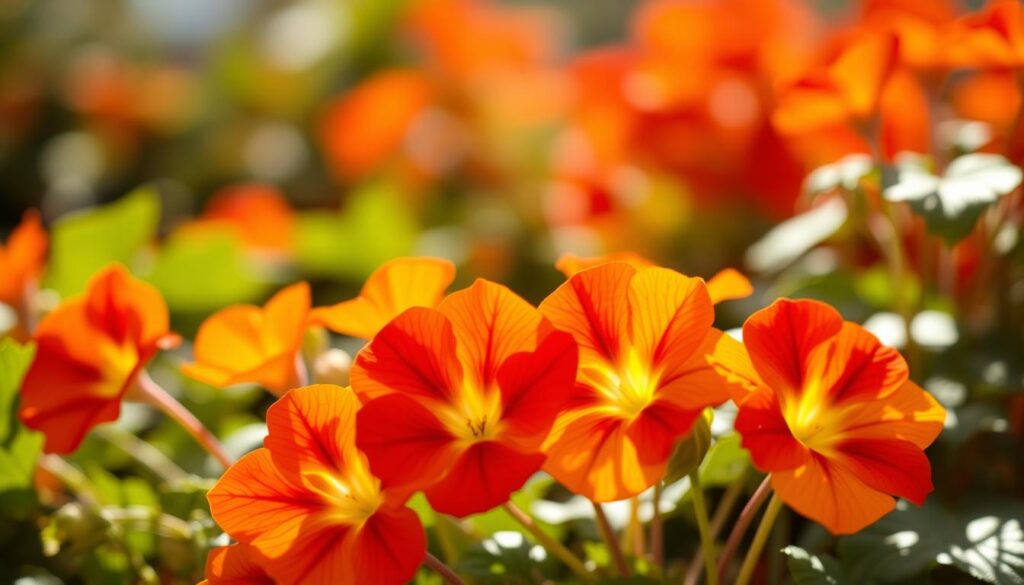
Seasonal Planting Tips
Timing plays a significant role in ensuring the health of your nasturtiums and the overall vitality of your garden. Recognizing the best seasons for planting allows you to create an effective planting schedule that maximizes growth and productivity. Leveraging optimal planting times sets the foundation for a flourishing garden through the seasons.
Best Times to Plant Nasturtiums
The ideal time for planting nasturtiums coincides with the arrival of spring. Waiting until after the last frost enables these plants to thrive in their growing environment. Planting during this window supports the success of your seasonal gardening efforts and enhances the quality of your flowers and vegetables.
How to Space Your Plants
Proper plant spacing is essential for maximizing the benefits of companion planting techniques. Nasturtiums require enough room to ensure good air circulation, preventing mold and providing adequate light for neighboring plants. Adhering to recommendations for plant spacing promotes optimal plant arrangements, leading to a healthier garden and improved crop outcomes.
Rotating Crops for Healthier Garden
Embracing crop rotation contributes to soil health and pest management. By interchanging nasturtiums with other vegetables, you can mitigate pest infestations and foster healthy soil. Effective garden management through crop rotation not only enhances the vitality of your plants but also aligns with sustainable gardening practices that maintain ecological balance.
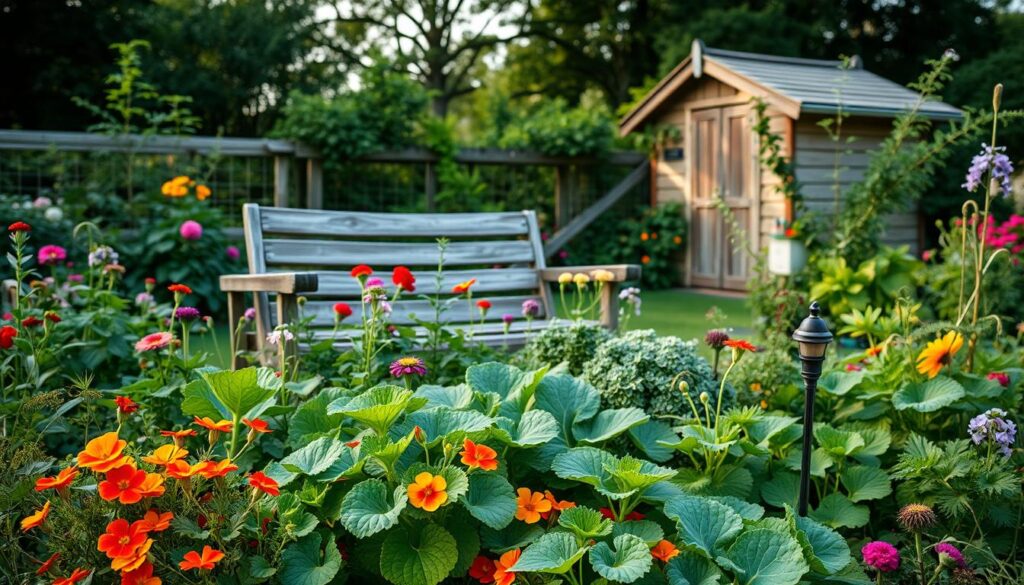
Watering and Care for Nasturtiums
Nasturtiums are beautiful and resilient plants that thrive with proper care and attention. By following effective watering practices, you can ensure they flourish in your garden. Additionally, understanding the best fertilization methods and pest management strategies contributes to maintaining healthy plants.
General Watering Guidelines
Watering practices for nasturtiums focus on providing adequate moisture without the risk of over-watering. These plants prefer well-drained soil, which helps prevent root rot. Regular watering is essential, particularly during dry spells. Monitor the soil for dryness, allowing it to dry slightly between watering sessions to promote optimal growth.
Fertilization Tips
Feeding nasturtiums involves using organic gardening techniques to enhance their growth. While nasturtiums can survive in poorer soils, incorporating organic fertilizers, such as compost, can significantly improve flowering and overall health. A balanced approach to fertilization supports maintaining healthy plants and increases the beauty of your garden.
Pest Management Strategies
Pest management is critical for preserving your nasturtium plants. Regular monitoring of your garden helps in controlling garden pests effectively. Employing physical barriers like row covers and introducing beneficial insects encourages a balanced ecosystem. These pest management strategies ensure a thriving garden environment without reliance on harsh chemicals.

| Aspect | Best Practices |
|---|---|
| Watering | Regularly check soil moisture; water when dry |
| Fertilization | Use organic compost during the growing season |
| Pest Management | Encourage beneficial insects and monitor regularly |
Common Pests and Problems
In any garden, encountering pests and diseases can be a challenging endeavor. Understanding common threats to your plants, such as aphids, powdery mildew, and snails or slugs, is crucial for effective garden pest management. Here’s a closer look at these issues and how you can address them.
Aphids: Identifying and Controlling
Aphids are small, sap-sucking insects that can quickly become a pest problem for nasturtiums and other plants. Early pest identification is essential for effective aphid control. Look for curled leaves or sticky residue on your plants. Introducing beneficial insects like ladybugs can naturally help in managing their population. Companion planting with strong-scented plants can further deter aphids. Regular monitoring allows you to catch these pests before they cause significant damage.
Powdery Mildew: Prevention and Treatment
Powdery mildew is a fungal disease that presents as white, powdery spots on leaves. It thrives in humid conditions, making powdery mildew management an essential aspect of plant disease prevention. Ensuring proper spacing between plants promotes airflow, reducing humidity and limiting the spread of mildew. If powdery mildew appears, consider treating plant diseases with organic fungicides. Keeping your garden clean and removing infected foliage can also aid in preventing future outbreaks.
Snails and Slugs: Keeping Them Away
Controlling snails and slugs can be a significant concern for any gardener. These pests tend to appear during moist conditions, feeding on tender leaves and flowers. Implementing slug management strategies, such as creating barriers with crushed eggshells or copper tape, can help keep them at bay. Handpicking snails during the evening can provide immediate relief. Furthermore, cultivating nasturtiums can divert these pests from more prized plants, serving as an effective natural deterrent.
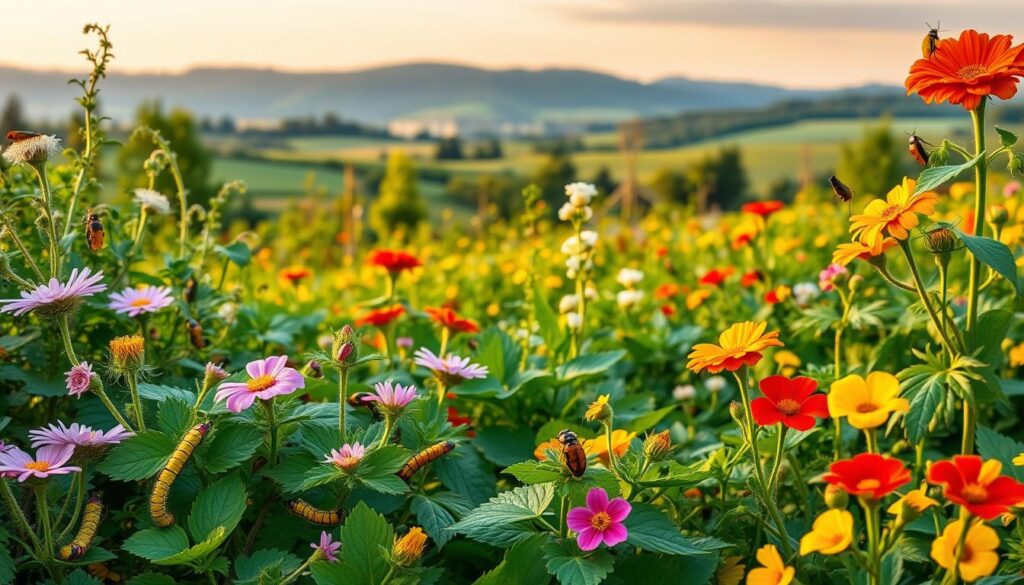
Growing Nasturtiums in Containers
Container gardening offers a wonderful opportunity to cultivate nasturtiums, especially if space is limited. To succeed in growing nasturtiums in containers, it is important to select the right pots and provide the optimal soil mix while ensuring consistent maintenance.
Choosing the Right Container
For the best results with nasturtiums, choose pots that allow for adequate drainage and provide enough space for growth. The best pots are typically at least 12 inches in diameter to accommodate their spreading habit. Consider using terracotta or ceramic containers, as they help regulate temperature and moisture, facilitating a healthy environment for root development.
Soil Requirements
The right container soil plays a crucial role in the growth of nasturtiums. A good soil mix for these plants should be well-draining, rich in organic matter, and able to retain moisture. Combine potting soil with compost to create a nutrient-rich growing medium for nasturtiums. This combination ensures that your plants have access to essential nutrients while preventing waterlogging, which can lead to root rot.
Maintenance Tips
Caring for potted nasturtiums involves several pot care techniques. Regular container maintenance includes ensuring the plants receive adequate watering, particularly during dry spells. Monitor for pests, as these can negatively impact your flowers and leaves. Rotate your containers occasionally to ensure balanced sun exposure, promoting even growth throughout your nasturtiums.
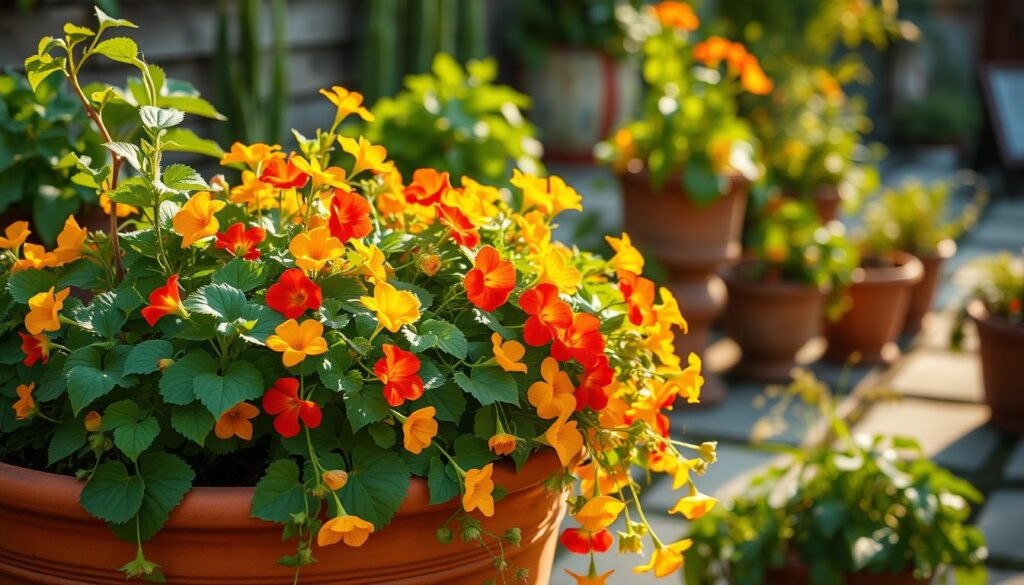
Creating a Companion Planting Chart
Creating a companion planting chart is essential for effective garden planning. By organizing what plants to pair with nasturtiums, you set the foundation for successful gardening and maximizing crop yields. Strategic planting decisions enhance biodiversity, making your garden not only beautiful but also healthier.
Planning Your Companion Planting
Planning for garden success involves understanding which plants work best together. Use a companion planting chart to map out your garden layout. This chart can help you determine which crops benefit most from the presence of nasturtiums. Effective plant arrangements can provide mutual support, leading to a thriving garden ecosystem.
Visualizing Plant Arrangements
Visualizing plant positions within your garden allows for better space utilization. A well-organized companion planting chart aids in understanding how plants interrelate. Incorporating nasturtiums into your layout increases the potential for enhancing plant health, particularly when paired with compatible vegetables and other flowers.
Benefits of Successful Companionship
The benefits of companion planting extend beyond just aesthetics. Improved pest control and enhanced flavor profile of crops contribute to successful gardening outcomes. Including nasturtiums in your gardening practice promotes a flourishing environment that supports overall plant vitality.
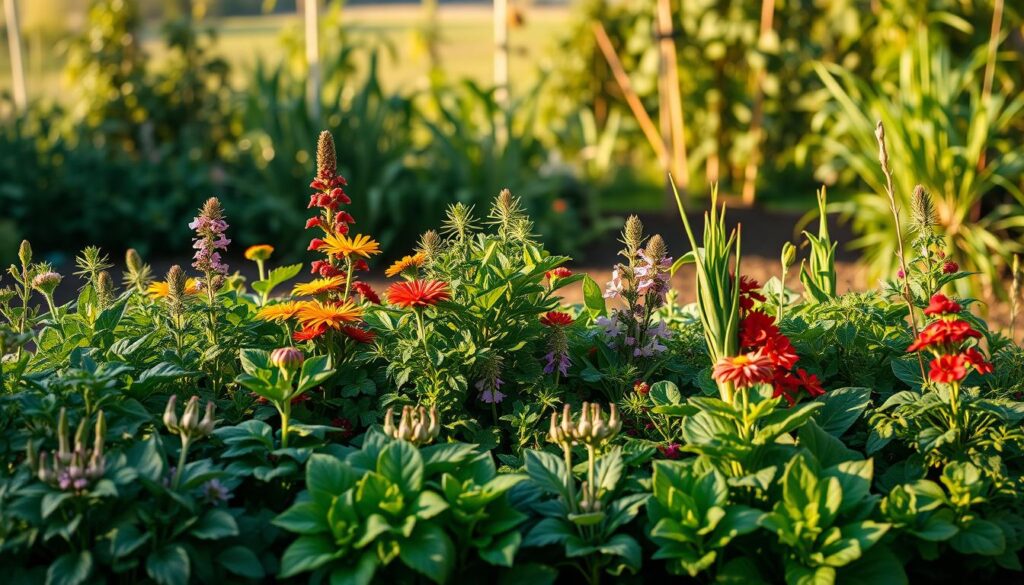
Expanding Your Companion Planting Knowledge
Enhancing your understanding of companion planting can greatly benefit your gardening journey. Various gardening resources, including companion planting books and learning materials, are available to provide valuable insights and strategies. These tools will help you cultivate a thriving star plant, the nasturtium, alongside your favorite companions.
Resources for Further Reading
Numerous gardening resources exist, including books and articles dedicated to companion planting. They offer tips, strategies, and case studies that can inform your practices. Explore well-regarded titles and online guides that provide essential gardening wisdom tailored for your specific environment.
Local Gardening Workshops
Getting involved in local gardening workshops provides an excellent opportunity for hands-on learning. Participating in these events allows you to connect with fellow gardening enthusiasts, share personal experiences, and deepen your understanding of companion planting techniques. Look for community gardening events in your area to enhance your skills and learn about the benefits of community gardening.
Community Gardening Benefits
Engaging in community gardening fosters cooperation and nurturing relationships among neighbors. Gardening together creates a sense of belonging and allows for shared gardening experiences, which can enrich your knowledge and skills. Learning about the optimal combination of nasturtiums with other plants leads to a healthier garden overall.
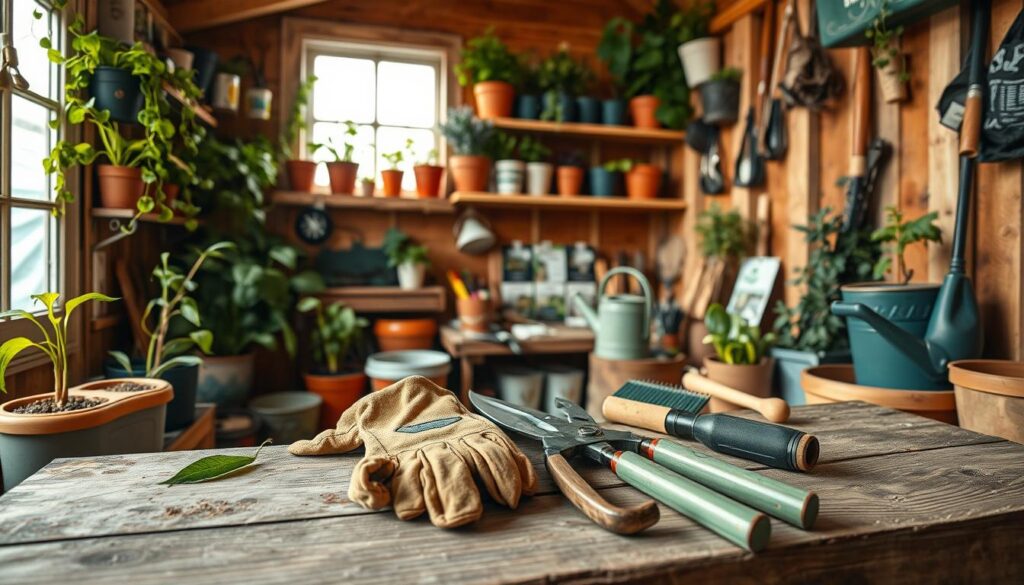
Conclusion: Create Your Perfect Garden
As you embark on your gardening journey, understanding the benefits of nasturtiums will help you cultivate a thriving garden. These vibrant flowers not only offer stunning visuals but also act as effective pest deterrents. Their ability to enhance soil health and provide culinary delights further cements their role in your planting strategy. By incorporating nasturtiums, you can experience a myriad of garden benefits that improve overall productivity.
To effectively start your garden, consider the next steps for planting nasturtiums alongside compatible companion plants. This careful planning, coupled with proper care guidelines, ensures a flourishing environment for all plants involved. As you develop your garden layout, think about how these flowers can complement the other greens, maximizing their companion plant advantages.
Ultimately, embracing the beauty of companion planting not only enhances the aesthetics of your garden but also rewards you with a healthier ecosystem. Enjoying gardening becomes effortless when your space is filled with vibrant colors, enticing flavors, and fewer pests. With nasturtiums at the forefront, you’ll find joy in every aspect of nurturing your garden.
